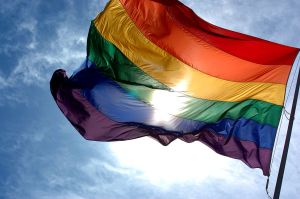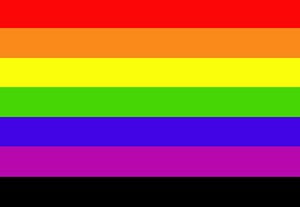
The next symbol I learned about was the pink triangle. Since it was an emblem used by the Nazis to mark prisoners sent to the concentration camps with the excuse that they were sexual deviants, and since the Allies had then re-imprisoned all of the gay men who managed to survive the camps, the emblem was more of an assertion of “never again!” than a pure statement of pride.
Of course, since Gilbert Baker designed the very first Rainbow Pride flag during my junior year in high school, it’s not surprising that I didn’t learn about the emblem until some time later…
The original two flags were hand-dyed and hand-stitched under supervision of artist Gilbert Baker for San Francisco’s Gay Freedom Day Parade held on June 25, 1978. Baker assigned each of the eight stripes (hot pink, red, orange, yellow, green, turquoise, indigo, and violet) a specific meaning (sexuality, life, healing, sunlight, nature, art or magic, harmony, and spirit). After the assassination of Harvey Milk in November of that same year, there was a sudden demand for rainbow flags from the community. Baker found a company to manufacture them, but the company couldn’t obtain enough hot pink fabric, so the flags that suddenly were being waved by protesters and hung up around San Francisco had only seven stripes.

When I was first coming out in the mid-80s, the Pink Triangle was what it seemed everyone was wearing as jewelry and clothing patches, et cetera. The Rainbow flag came out at Pride time, of course but Pink Triangles ruled. Then something happened in the late 80s/early 90s and there seemed to be a rainbow on everything. You couldn’t visit the local gayborhood without seeing rainbows everywhere. A few people attributed it to a lawsuit that national news services picked up in 1989 when a gay man successfully sued for the right to fly the rainbow flag from his apartment’s balcony over his landlord’s objections. Others said that many lesbians felt that the pink triangle was really only a gay male symbol, but found the rainbow more inclusive.
And of course there was a backlash. A comedian/theatre guy did a routine/skit called “I’m SO over the rainbow” that a lot of male acquaintances of a certain age kept forcing me to watch or listen to. I wish I could track down his name to properly credit him. Though since I think he came across as a bitter old queen who was just angry that younger gay men seemed to be more interested in living happy out lives than being constantly outraged about being oppressed like they did in his day, maybe it’s a good thing I don’t.

I happen to love the Rainbow Pride flag. I like to think that the story some tell of how Baker was originally inspired by the Flag of the Races which was used by some in the anti-war/pro-racial equality movement in the late 60s and early 70s is true. Because I agree that the rainbow evokes that idea of people of different ethnic groups, cultural backgrounds, and sexualities all working side-by-side. It represents diversity. I’ll even admit that the fact that some rightwing religious nuts consider it blasphemy that the biblical symbol of a promise from god not to destroy the world with flood has been adopted as a symbol of hope by us queers. But having been raised in the evangelical culture, I also like to think that the rainbow’s biblical promise of hope applies to us, too.
I would really like to get hold of one in the original 8 colors. One of the few times anyone asked me why, I said my inner packrat/collector likes completeness, so technically I’d really like to own a lot of the other variations of the rainbow flag, as well. That answer is true, but incomplete. Honestly, I just really would love for the hot pink to make a comeback. Because while everyone knows purple is my favorite color, hot pink is an awfully close second.
1 thought on “Colors of the rainbow so pretty in the sky, also on the faces of people passing by”